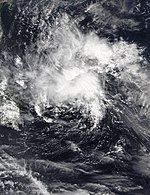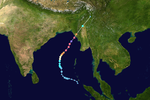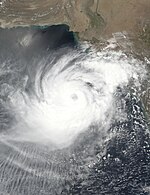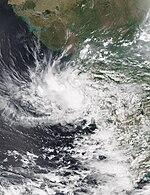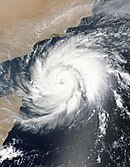2023 North Indian Ocean cyclone season: Difference between revisions
| Line 222: | Line 222: | ||
|Pressure=998 |
|Pressure=998 |
||
}} |
}} |
||
On October 21, Tropical Depression 06B formed in the Arabian Sea. It was upgraded to a Cyclonic Storm on October 23. |
|||
{{clear}} |
{{clear}} |
||
Revision as of 18:52, 23 October 2023
| 2023 North Indian Ocean cyclone season | |
|---|---|
 Season summary map | |
| Seasonal boundaries | |
| First system formed | 30 January 2023 |
| Last system dissipated | Season ongoing |
| Strongest storm | |
| Name | Mocha |
| • Maximum winds | 215 km/h (130 mph) (3-minute sustained) |
| • Lowest pressure | 938 hPa (mbar) |
| Seasonal statistics | |
| Depressions | 6, 1 unofficial |
| Deep depressions | 4, 1 unofficial |
| Cyclonic storms | 4, 1 unofficial |
| Severe cyclonic storms | 3 |
| Very severe cyclonic storms | 3 |
| Extremely severe cyclonic storms | 3 (record high, tied with 1999 and 2019) |
| Super cyclonic storms | 0 |
| Total fatalities | 480 total |
| Total damage | $1.6 billion (2023 USD) |
| Related articles | |
The 2023 North Indian Ocean cyclone season is an ongoing event in the annual cycle of tropical cyclone formation.[1] The North Indian Ocean cyclone season has no official bounds, but cyclones tend to form between April and December, with the peak from May to November. These dates conventionally delimit the period of each year when most tropical cyclones form in the northern Indian Ocean.
The scope of this article is limited to the Indian Ocean in the Northern Hemisphere, east of the Horn of Africa and west of the Malay Peninsula. There are two main seas in the North Indian Ocean — the Arabian Sea to the west of the Indian subcontinent, abbreviated ARB by the India Meteorological Department (IMD); and the Bay of Bengal to the east, abbreviated BOB by the IMD.
The official Regional Specialized Meteorological Centre in this basin is the India Meteorological Department (IMD), while the Joint Typhoon Warning Center releases unofficial advisories for interest. On average, three to four cyclonic storms form in this basin every season.[2]
Season summary

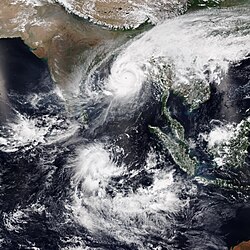
Nearing the end of January, a tropical depression classified as BOB 01 formed, becoming the first storm in the basin. The storm's formation makes it the first time since 2019 to see a storm develop in the month of January in the basin. BOB 01 was short-lived and dissipated after making landfall on Sri Lanka.
After almost four months of inactivity, the IMD began to monitor a disturbance which was located in the Bay of Bengal on May 6. The system steadily improved and was upgraded into a Depression by the IMD with it being classified as BOB 02. Soon afterwards on May 10, it intensified to a Deep Depression. On the next day, it strengthened into a Cyclonic Storm with the IMD naming the system Mocha. Mocha afterwards, began to rapidly intensify and reached its peak intensity as a Category 5-equivalent cyclone on May 14. Mocha then made landfall just north of Sittwe, Myanmar as a Category 4-equivalent cyclone. The cyclone then rapidly weakened and was last noted over the Chinese province of Yunnan on May 15. Mocha caused heavy damage across Myanmar and Bangladesh and killed at least 400 people. On June 6, a Depression formed in the Arabian Sea, which was later named Biparjoy and rapidly intensified to a Category 1-equivalent cyclone. On June 9, Tropical Storm 03B was designated by the JTWC in the Bay of Bengal.[3] On July 31, a low-pressure area developed into Tropical Storm 04B, which was designated by the JTWC. On September 30, ARB 02 formed.
The season has also produced the second-most accumulated cyclone energy in this basin on record, only behind 2019. [citation needed]
Systems
Depression BOB 01
| Depression (IMD) | |
| Duration | 30 January – 2 February |
|---|---|
| Peak intensity | 45 km/h (30 mph) (3-min); 1004 hPa (mbar) |
On 25 January, a cyclonic circulation formed over the equatorial Indian Ocean and the adjoining Bay of Bengal.[4] Under an influence of cyclonic circulation, a low-pressure area formed on 27 January.[5] Substantially, it concentrated into a well-marked low-pressure area on 29 January.[6] During the next day, the well-marked low organized to depression.[7] The JTWC later issued a Tropical Cyclone Formation Alert (TCFA) for the system.[8] However, increasing land interaction with Sri Lanka prompted the JTWC to downgrade the system's chance for development to medium and subsequently canceling its TCFA.[9] The disturbance finally weakened into a well-marked low pressure over Gulf of Mannar on 2 February.[10]
Extremely Severe Cyclonic Storm Mocha
| Extremely severe cyclonic storm (IMD) | |
| Category 5 tropical cyclone (SSHWS) | |
| Duration | 9 May – 15 May |
|---|---|
| Peak intensity | 215 km/h (130 mph) (3-min); 938 hPa (mbar) |
A circulation formed on 6 May over the Bay of Bengal as a result of the amplitude of the Madden–Julian oscillation (MJO), according to the IMD.[11] The JTWC also began monitoring the system on 7 May, marking its flaring convection to the west of the circulation.[12] On 9 May, the system was upgraded to a depression.[13] The JTWC later issued a TCFA on the system as it was situated in very warm sea surface temperatures.[14] The storm subsequently intensified into a deep depression at 03:00 UTC of 9 May,[15] before upgrading further to a cyclonic storm on 11 May, attaining the name Mocha.[16] The JTWC followed suit in upgrading the system to tropical cyclone status the same day.[17] Mocha quickly intensified to a severe cyclonic storm at 12:00 UTC after reaching winds of 105 km/h (65 mph).[18] After forming an eye,[19] Mocha became a very severe cyclonic storm on 12 May.[20] Mocha rapidly intensified to an extremely severe cyclonic storm at 18:00 UTC,[21] before undergoing an eyewall replacement cycle.[22] After having completing the cycle on 13 May, Mocha rapidly intensified and reached a peak intensity as a Category 5-equivalent tropical cyclone the next day,[23] shortly before the storm entered unfavorable conditions.[24] Mocha weakened before making landfall near Sittwe of Myanmar.[25] Mocha began to rapidly weaken after landfall from Myanmar's terrain, with wind shear also degrading the storm.[26] The system downgraded to a depression on 15 May,[27] shortly before becoming marked as a low-pressure area.[28]
The death toll from Cyclone Mocha varies significantly. ASEAN reported a total of 145 deaths,[29] whereas the National Unity Government of Myanmar (NUG) stated that Mocha killed at least 463 people, including three indirect deaths in Bangladesh. The cyclone also injured 719 people and left 101 others missing.[30] It caused about US$1.5 billion of damage in Myanmar.[31]
Extremely Severe Cyclonic Storm Biparjoy
| Extremely severe cyclonic storm (IMD) | |
| Category 3 tropical cyclone (SSHWS) | |
| Duration | 6 June – 19 June |
|---|---|
| Peak intensity | 165 km/h (105 mph) (3-min); 958 hPa (mbar) |
A cyclonic circulation formed over the Arabian Sea on 5 June.[32] On the same day, a low-pressure area formed as a result of cyclonic circulation.[33] The following day, it significantly intensified into a depression.[34] The JTWC issued a TCFA on the system.[35] The IMD upgraded the depression to a deep depression, and subsequently to a Cyclonic Storm Biparjoy.[36][37] The JTWC subsequently classified it as Tropical Cyclone 02A. [38] By 00:00 UTC on 7 June, the IMD upgraded the system to a severe cyclonic storm with winds of 100 km/h (65 mph).[39] Biparjoy cloud tops warmed and the convective burst collapsed, resulting in an upper-level outflow from the storm and pushing it back towards its system core.[40] Biparjoy was upgraded to a very severe cyclonic storm at 06:00 UTC, at which point the system became a Category 2-equivalent tropical cyclone.[41][42] The cyclone was sheared due to moderate easterly vertical wind shear, with the deep convection displaced from the LLCC.[43] Biparjoy unexpectedly rapidly intensified and became a Category 3-equivalent cyclone on 11 June.[44][45] Biparjoy reached its peak intensity as an extremely severe cyclonic storm, with maximum 3-minute sustained winds of 165 km/h (105 mph).[46] The shear decreased and convective organization and areal extent increased.[47] Biparjoy gradually weaken with convective banding over the northern semicircle.[48] Biparjoy made landfall on 16 June near Naliya, India, with sustained winds of 95 km/h (60 mph).[49][50] Shortly after the landfall, the JTWC discontinued warnings on the system.[49] The cyclone was later marked as a well-marked low-pressure area by the IMD on 19 June, prompting the discontinuation of advisories on the system.[51]
In Pakistan, 81,000 individuals were evacuated from the southeastern coast, and authorities have established 75 relief camps at schools to provide assistance.[52] At least 23 people were injured as well as 4,600 villages were affected by power outages in India.[53] A total of 12 people were confirmed to have been killed by the storm.[54][55][56]
Deep Depression BOB 03
| Deep depression (IMD) | |
| Tropical storm (SSHWS) | |
| Duration | 31 July – 3 August |
|---|---|
| Peak intensity | 55 km/h (35 mph) (3-min); 988 hPa (mbar) |
On 29 July the IMD noted a cyclonic circulation forming over North Odisha and nearby Gangetic West Bengal. On the same day, it noted the formation of low pressure area over same region and on next day it moved over the Northeastern part of Bay of Bengal.[57] By the same time at 06:00 UTC on 31 July, the JTWC designated it as Invest 95B and gave low chance of developing.[citation needed] Despite its low level circulation exposed, it continued to intensify and at 12:00 UTC of the same day, the IMD upgraded it to a well marked low.[57] On 21:00 UTC, the JTWC upgraded it to a tropical storm designated as 04B and peaked as a 40 kt storm.[citation needed] On 00:00 UTC of 1 August, the IMD upgraded it to a Depression designated as BOB 03. It continued to intensify till Deep Depression intensity off the coast of Bangladesh and made landfall at Khepupara in Bangladesh at 12:00 UTC.[57] The JTWC stopped issuing advisories by 06:00 UTC stating that it made landfall.[citation needed] It continued to move into Eastern India while maintaining intensity. It weakened into Depression over Jharkhand on 2 August 18:00 UTC. Continued to move west-northwest, it became a well-marked low pressure area over north Chhattisgarh and nearby region by 12:00 UTC on 3 August.[57]
Depression ARB 02
| Depression (IMD) | |
| Duration | 30 September – 1 October |
|---|---|
| Peak intensity | 45 km/h (30 mph) (3-min); 1002 hPa (mbar) |
IMD marked a low pressure area off the Konkan coast and rapidly upgraded into a depression designated as ARB 02 on 30 September.[58] ARB 02 made landfall with the same speed and caused heavy rainfall that day. It moved overland and later gradually weakened into a well marked low pressure area by the IMD on 1 October.
Extremely Severe Cyclonic Storm Tej
| |||
On 16 October 2023, the India Meteorological Department (IMD) began monitoring the potential for a formation of a cyclonic circulation in the Arabian Sea.[59] In Arabian Sea, the relatively higher sea surface temperature, pointing to positive Indian Ocean Dipole, created the favourable condition for the formation of cyclogenesis.[60] A cyclonic circulation formed over the Arabian Sea on 16 October.[59] A low-pressure area formed as a result of the cyclonic circulation on morning of 18 October. It intensified into Depression on 21 October. At the same day, the system intensified into Cyclonic Storm, received the name Tej.
Current storm information
For the latest official information, see:
- IMD's Tropical Cyclone Advisory on Very Severe Cyclonic Storm Tej
- JTWC's Tropical Cyclone Warning on Tropical Cyclone 05A (Tej)
Cyclonic Storm Hamoon
| Cyclonic storm (IMD) | |
| Tropical storm (SSHWS) | |
| Duration | 21 October – present |
|---|---|
| Peak intensity | 75 km/h (45 mph) (3-min); 998 hPa (mbar) |
On October 21, Tropical Depression 06B formed in the Arabian Sea. It was upgraded to a Cyclonic Storm on October 23.
Other system
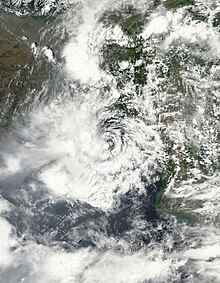
Under the influence of another cyclonic circulation, a low-pressure area formed over the northeast Bay of Bengal on 9 June,[61] which later concentrated into a well-marked low-pressure area on the same day.[62] The JTWC reported that the system had become a Tropical Cyclone 03B after its low-level circulation center became fully exposed within disorganized convection on the western semicircle of the storm.[3][63] The system weakened back into a low-pressure area over Bangladesh and IMD issued the last advisory.[64] The JTWC also discontinued warnings on the system around 03:00 UTC on 10 June.[65]
Storm names
Within this basin, a tropical cyclone is assigned a name when it is judged to have reached cyclonic storm intensity with winds of 65 kilometres per hour (40 mph). The names were selected by a new list from the Regional Specialized Meteorological Center in New Delhi by mid year of 2020.[66] There is no retirement of tropical cyclone names in this basin as the list of names is only scheduled to be used once before a new list of names is drawn up. Should a named tropical cyclone move into the basin from the Western Pacific, then it will retain its original name. The next eight available names from the List of North Indian Ocean storm names are below.[67]
|
Season effects
This is a table of all storms in the 2023 North Indian Ocean cyclone season. It mentions all of the season's storms and their names, duration, peak intensities according to the IMD storm scale, damage, and death totals. Damage and death totals include the damage and deaths caused when that storm was a precursor wave or extratropical low. All of the damage figures are in 2023 USD.
| Name | Dates | Peak intensity | Areas affected | Damage (USD) |
Deaths | Refs | ||
|---|---|---|---|---|---|---|---|---|
| Category | Wind speed | Pressure | ||||||
| BOB 01 | 30 January – 2 February | Depression | 45 km/h (30 mph) | 1004 hPa (29.65 inHg) | Sri Lanka | None | 0 | |
| Mocha | 9–15 May | Extremely severe cyclonic storm | 215 km/h (130 mph) | 938 hPa (27.70 inHg) | Andaman and Nicobar Islands, Sri Lanka, Myanmar, Bangladesh, India, China | $1.5 billion | 463 | [68][25] |
| Biparjoy | 6–19 June | Extremely severe cyclonic storm | 165 km/h (105 mph) | 958 hPa (28.29 inHg) | India, Pakistan | $124 million | 17 | |
| 03B | 9–10 June | Tropical storm | 75 km/h (45 mph)[nb 1] | 991 hPa (29.26 inHg) [nb 2] | Myanmar, Bangladesh | None | 0 | |
| BOB 03 | 31 July – 3 August | Deep depression | 55 km/h (35 mph) | 988 hPa (29.18 inHg) | Myanmar, Bangladesh, West Bengal, Jharkhand, Odisha, Bihar, Chhattisgarh | None | 0 | |
| ARB 02 | 30 September – 1 October | Depression | 45 km/h (30 mph) | 1002 hPa (29.59 inHg) | Goa, Maharashtra, Karnataka | None | 0 | |
| Tej | 20 October – present | Extremely severe cyclonic storm | 175 km/h (110 mph) | 959 hPa (28.32 inHg) | Socotra | None | 0 | |
| Hamoon | 21 October – present | Cyclonic storm | 75 km/h (45 mph) | 998 hPa (29.47 inHg) | None | None | 0 | |
| Season aggregates | ||||||||
| 7 systems (1 unofficial) |
30 January – Season ongoing | 215 km/h (130 mph) | 938 hPa (27.70 inHg) | $1.6 billion | 480 | |||
See also
- Weather of 2023
- Tropical cyclones in 2023
- North Indian Ocean cyclone season
- 2023 Atlantic hurricane season
- 2023 Pacific hurricane season
- 2023 Pacific typhoon season
- South-West Indian Ocean cyclone seasons: 2022–23, 2023–24
- Australian region cyclone seasons: 2022–23, 2023–24
- South Pacific cyclone seasons: 2022–23, 2023–24
Notes
- ^ As the IMD did not recognise this system as a tropical cyclone, this wind estimate is from the JTWC and thus sustained over one minute (as opposed to three minutes for the other wind estimates in this table).
- ^ As the IMD did not recognise this system as a tropical cyclone, this pressure estimate is from the JTWC.
References
- ^ "Climatology of Tropical Cyclones over North Indian Ocean (NIO)" (PDF). severeweather.wmo.int. 8 December 2022. Archived (PDF) from the original on 6 March 2023. Retrieved 8 December 2022.
- ^ "Annual Frequency of Cyclonic Disturbances (Maximum Wind Speed of 17 Knots or More), Cyclones (34 Knots or More) and Severe Cyclones (48 Knots or More) Over the Bay of Bengal (BOB), Arabian Sea (AS) and Land Surface of India" (PDF). India Meteorological Department. Archived (PDF) from the original on 15 December 2017. Retrieved 30 October 2015.
- ^ a b Prognostic Reasoning for Tropical Cyclone 03B (Three) Warning No. 1 (Report). United States Joint Typhoon Warning Center. 9 June 2023. Archived from the original on 12 June 2023. Retrieved 12 June 2023.
- ^ Tropical Weather Outlook for North Indian Ocean issued at 0600 UTC of 25.01.2023. based on 0300 UTC of 25.01.2023 (PDF) (Report). New Delhi, India: India Meteorological Department. 25 January 2023. Archived (PDF) from the original on 7 February 2023. Retrieved 12 May 2023.
- ^ Tropical Weather Outlook for North Indian Ocean issued at 0600 UTC of 27.01.2023. based on 0300 UTC of 27.01.2023 (PDF) (Report). New Delhi, India: India Meteorological Department. 27 January 2023. Archived from the original (PDF) on 12 May 2023. Retrieved 12 May 2023.
- ^ Tropical Weather Outlook for North Indian Ocean issued at 0600 UTC of 29.01.2023. based on 0300 UTC of 29.01.2023 (PDF) (Report). New Delhi, India: India Meteorological Department. 29 January 2023. Retrieved 12 May 2023.
- ^ Special Tropical Weather Outlook for North Indian Ocean issued at 0730 UTC of 30.01.2023. based on 0300 UTC of 30.01.2023 (PDF) (Report). New Delhi, India: India Meteorological Department. 29 January 2023. Archived from the original (PDF) on 12 May 2023. Retrieved 12 May 2023.
- ^ Tropical Cyclone Formation Alert (Invest 90B) (Report). United States Joint Typhoon Warning Center. 31 January 2023. Archived from the original on 31 January 2023. Retrieved 31 January 2023.
- ^ Tropical Cyclone Formation Alert (Invest 90B) (Report). United States Joint Typhoon Warning Center. 1 February 2023. Archived from the original on 31 January 2023. Retrieved 1 February 2023. Alt URL
- ^ Speacial Tropical Weather Outlook for North Indian Ocean issued at 1930 UTC of 02.02.2023. based on 1800 UTC of 02.02.2023 (PDF) (Report). New Delhi, India: India Meteorological Department. 2 February 2023. Archived from the original (PDF) on 12 May 2023. Retrieved 12 May 2023.
- ^ Tropical Weather Outlook for North Indian Ocean issued at 0700 UTC of 06.05.2023 based on 0300 UTC of 06.05.2023 (Report). New Delhi, India: India Meteorological Department. 6 May 2023. Archived from the original on 9 May 2023. Retrieved 9 May 2023.
- ^ Significant Tropical Weather Advisory for the Indian Ocean, 18Z 7 May 2023 (Report). United States Joint Typhoon Warning Center. 7 May 2023. Archived from the original on 7 May 2023. Retrieved 9 May 2023.
- ^ Tropical Weather Outlook for North Indian Ocean issued at 1600 UTC of 09.05.2023. based on 1200 UTC of 09.05.2023 (Report). New Delhi, India: India Meteorological Department. 9 May 2023. Archived from the original on 10 May 2023. Retrieved 9 May 2023.
- ^ Tropical Cyclone Formation Alert (Invest 91B) (Report). United States Joint Typhoon Warning Center. 9 May 2023. Archived from the original on 9 May 2023. Retrieved 9 May 2023. Alt URL
- ^ Special Tropical Weather Outlook for North Indian Ocean issued at 2030 UTC of 10.05.2023. based on 1800 UTC of 10.05.2023 (PDF) (Report). New Delhi, India: India Meteorological Department. 9 May 2023. Archived (PDF) from the original on 11 May 2023. Retrieved 9 May 2023.
- ^ Quadrant Wind Distribution in Association with Mocha over Bay of Bengal on 0000 UTC of 11-05-2023 (Report). New Delhi: India Meteorological Department. 11 May 2023. Archived from the original on 11 May 2023. Retrieved 11 May 2023.
- ^ Prognostic Reasoning for Tropical Cyclone 01B (One) Warning No. 1 (Report). United States Joint Typhoon Warning Center. 11 May 2023. Archived from the original on 11 May 2023. Retrieved 11 May 2023. Alt URL
- ^ Tropical Cyclone Advisory No. 5 for North Indian Ocean issued at 1500 UTC of 11.05.2023. based on 1200 UTC of 11.05.2023 (PDF) (Report). New Delhi, India: India Meteorological Department. 11 May 2023. Archived from the original (PDF) on 11 May 2023. Retrieved 11 May 2023.
- ^ Prognostic Reasoning for Tropical Cyclone 01B (Mocha) Warning No. 4 (Report). United States Joint Typhoon Warning Center. 11 May 2023. Archived from the original on 11 May 2023. Retrieved 11 May 2023. Alt URL
- ^ High Sea For Met. Area VIII (N) (Report). New Delhi, India: India Meteorological Department. 12 May 2023. Archived from the original on 12 May 2023. Retrieved 12 May 2023.
- ^ Tropical Cyclone Advisory No. 15 for North Indian Ocean issued at 2100 UTC of 12.05.2023. based on 1800 UTC of 12.05.2023 (PDF) (Report). New Delhi, India: India Meteorological Department. 12 May 2023. Archived from the original (PDF) on 12 May 2023. Retrieved 12 May 2023.
- ^ Prognostic Reasoning for Tropical Cyclone 01B (Mocha) Warning No. 8 (Report). United States Joint Typhoon Warning Center. 12 May 2023. Archived from the original on 12 May 2023. Retrieved 12 May 2023. Alt URL
- ^ Prognostic Reasoning for Tropical Cyclone 01B (Mocha) Warning No. 13 (Report). United States Joint Typhoon Warning Center. 14 May 2023. Archived from the original on 14 May 2023. Retrieved 14 May 2023. Alt URL
- ^ Prognostic Reasoning for Tropical Cyclone 01B (Mocha) Warning No. 14 (Report). United States Joint Typhoon Warning Center. 14 May 2023. Archived from the original on 14 May 2023. Retrieved 14 May 2023. Alt URL
- ^ a b Alam, Julhas (14 May 2023). "Powerful Cyclone Mocha makes landfall in Myanmar, tearing off roofs and killing at least 3". AP News. Retrieved 14 May 2023.
- ^ Tropical Cyclone Advisory No. 30 for North Indian Ocean issued at 1630 UTC of 14.05.2023. based on 1500 UTC of 14.05.2023 (PDF) (Report). New Delhi, India: India Meteorological Department. 14 May 2023. Archived from the original (PDF) on 14 May 2023. Retrieved 14 May 2023.
- ^ Special Tropical Weather Outlook for North Indian Ocean issued at 0300 UTC of 15.03.2023. based on 0000 UTC of 15.05.2023 (PDF) (Report). New Delhi, India: India Meteorological Department. 15 May 2023. Archived from the original (PDF) on 15 May 2023. Retrieved 15 May 2023.
- ^ Special Tropical Weather Outlook for North Indian Ocean issued at 0700 UTC pf 15.05.2023. based on 0300 UTC of 15.05.2023 (PDF) (Report). New Delhi, India: India Meteorological Department. 15 May 2023. Archived from the original (PDF) on 15 May 2023. Retrieved 15 May 2023.
- ^ Situation Update No. 5 - Tropical Cyclone Mocha, Myanmar - 20 May 2023 (Report). ASEAN. 26 May 2023. Retrieved 26 May 2023.
- ^ Agarwal, Agushi (17 May 2023). "Cyclone Mocha: Myanmar government claims 435 people dead, seeks international aid". CNBC. Archived from the original on 17 May 2023. Retrieved 17 May 2023.
- ^ "Many feared dead after cyclone pummels western Myanmar". Reuters. 16 May 2023. Archived from the original on 16 May 2023. Retrieved 16 May 2023.
- ^ Tropical Weather Outlook for North Indian Ocean issued at 0600 UTC of 05.06.2023. based on 0300 UTC of 05.06.2023 (PDF) (Report). New Delhi, India: India Meteorological Department. 5 June 2023. Retrieved 11 June 2023.
- ^ Tropical Weather Outlook for North Indian Ocean issued at 1500 UTC of 05.06.2023. based on 1200 UTC of 05.06.2023 (PDF) (Report). New Delhi, India: India Meteorological Department. 5 June 2023. Retrieved 11 June 2023.
- ^ Special Tropical Weather Outlook for North Indian Ocean issued at 0500 UTC of 06.06.2023. based on 0000 UTC of 06.06.2023 (PDF) (Report). New Delhi, India: India Meteorological Department. 6 June 2023. Retrieved 11 June 2023.
- ^ Tropical Cyclone Formation Alert (Invest 92A) (Report). United States Joint Typhoon Warning Center. 5 June 2023. Archived from the original on 5 June 2023. Retrieved 5 June 2023. Alt URL
- ^ Tropical Cyclone Advisory 1 for North Indian Ocean issued at 1500 UTC of 06.06.2023. based on 1200 UTC of 06.06.2023 (PDF) (Report). New Delhi, India: India Meteorological Department. 6 June 2023. Retrieved 11 June 2023.
- ^ Special Tropical Weather Outlook for North Indian Ocean issued at 0930 UTC of 06.06.2023. based on 0600 UTC of 06.06.2023 (PDF) (Report). New Delhi, India: India Meteorological Department. 6 June 2023. Retrieved 11 June 2023.
- ^ Prognostic Reasoning for Tropical Cyclone 02A (Two) Warning No. 1 (Report). United States Joint Typhoon Warning Center. 6 June 2023. Archived from the original on 12 June 2023. Retrieved 12 June 2023.
- ^ Tropical Cyclone Advisory 5 for North Indian Ocean issued at 0330 UTC of 07.06.2023. based on 0000 UTC of 07.06.2023 (PDF) (Report). New Delhi, India: India Meteorological Department. 7 June 2023. Retrieved 11 June 2023.
- ^ Prognostic Reasoning for Tropical Cyclone 02A (Biparjoy) Warning No. 4 (Report). United States Joint Typhoon Warning Center. 7 June 2023. Archived from the original on 12 June 2023. Retrieved 12 June 2023.
- ^ Prognostic Reasoning for Tropical Cyclone 02B (Biparjoy) Warning No. 6 (Report). United States Joint Typhoon Warning Center. 7 June 2023. Archived from the original on 12 June 2023. Retrieved 12 June 2023.
- ^ Tropical Cyclone Advisory 7 for North Indian Ocean issued at 0930 UTC of 07.06.2023. based on 0600 UTC of 07.06.2023 (PDF) (Report). New Delhi, India: India Meteorological Department. 7 June 2023. Retrieved 12 June 2023.
- ^ Prognostic Reasoning for Tropical Cyclone 02A (Biparjoy) Warning No. 8 (Report). United States Joint Typhoon Warning Center. 8 June 2023. Archived from the original on 12 June 2023. Retrieved 12 June 2023.
- ^ Prognostic Reasoning for Tropical Cyclone 02A (Biparjoy) Warning No. 18 (Report). United States Joint Typhoon Warning Center. 10 June 2023. Archived from the original on 12 June 2023. Retrieved 12 June 2023.
- ^ Prognostic Reasoning for Tropical Cyclone 02B (Biparjoy) Warning No. 20 (Report). United States Joint Typhoon Warning Center. 11 June 2023. Archived from the original on 12 June 2023. Retrieved 12 June 2023.
- ^ Tropical Cyclone Advisory 37 for North Indian Ocean issued at 0345 UTC of 11.06.2023. based on 0000 UTC of 11.06.2023 (PDF) (Report). New Delhi, India: India Meteorological Department. 11 June 2023. Retrieved 12 June 2023.
- ^ Prognostic Reasoning for Tropical Cyclone 02A (Biparjoy) Warning No. 23 (Report). United States Joint Typhoon Warning Center. 11 June 2023. Archived from the original on 12 June 2023. Retrieved 12 June 2023.
- ^ Prognostic Reasoning for Tropical Cyclone 02A (Biparjoy) Warning No. 31 (Report). United States Joint Typhoon Warning Center. 13 June 2023. Archived from the original on 18 June 2023. Retrieved 13 June 2023.
- ^ a b Prognostic Reasoning for Tropical Cyclone 02A (Biparjoy) Warning No. 39 (Report). United States Joint Typhoon Warning Center. 15 June 2023. Archived from the original on 18 June 2023. Retrieved 15 June 2023.
- ^ Tropical Cyclone Advisory 76 for North Indian Ocean issued at 0350 UTC of 16.06.2023. based on 0000 UTC of 16.06.2023 (PDF) (Report). New Delhi, India: India Meteorological Department. 16 June 2023. Retrieved 16 June 2023.
- ^ National Bulletin No. 98 (ARB/01/2023) (PDF) (Report). New Delhi, India: India Meteorological Department. 19 June 2023. Retrieved 19 June 2023.
- ^ "Cyclone Biparjoy: More than 150,000 evacuated as India, Pakistan braces for storm". BBC News. 15 June 2023. Archived from the original on 15 June 2023. Retrieved 15 June 2023.
- ^ "Cyclone Biparjoy Live Updates: Rain in parts of Delhi under the influence of Cyclone Biparjoy". India Times. 13 June 2023. Retrieved 16 June 2023.
- ^ "Cyclone Biparjoy: 2 dead, 23 injured in Gujarat, confirms NDRF". India Today. Retrieved 16 June 2023.
- ^ Khanna, Sumit; Jadhav, Rajendra (13 June 2023). "Seven die as cyclone barrels towards western India, Pakistan". Reuters. Retrieved 16 June 2023.
- ^ "Woman killed, husband injured as tree falls on bike due to strong winds in Gujarat". India Today. Retrieved 16 June 2023.
- ^ a b c d Deep Depression over the Northeast Bay of Bengal (1 st – 3 rd August, 2023): A Report (PDF) (Report). New Delhi, India: Regional Specialized Meteorological Centre - Tropical Cyclones, India Meteorological Department. Retrieved 18 October 2023.
- ^ National Bulletin NO.2 (PDF) (Report). New Delhi, India: India Meteorological Department. 30 September 2023. Retrieved 30 September 2023.
- ^ a b Tropical Weather Outlook For North Indian Ocean (The Bay Of Bengal and the Arabian Sea) Valid for Next 168 Hours Issued at 0600 UTC of 17.10.2023 Based on 0300 UTC of 17.10.2023 (PDF) (Report). New Delhi, India: Regional Specialized Meteorological Centre - Tropical Cyclones, India Meteorological Department. 17 October 2023. Retrieved 18 October 2023.
- ^ Kallungal, Dhinesh (16 October 2023). "First post-monsoon cyclone of 2023 brewing over Arabian Sea". The Hindu. ISSN 0971-751X. Retrieved 18 October 2023.
- ^ Tropical Cyclone Advisory 22 for North Indian Ocean issued at 0700 UTC of 09.06.2023. based on 0300 UTC of 09.06.2023 (PDF) (Report). New Delhi, India: India Meteorological Department. 9 June 2023. Retrieved 9 June 2023.
- ^ Tropical Cyclone Advisory 23 for North Indian Ocean issued at 1000 UTC of 09.06.2023. based on 0600 UTC of 09.06.2023 (PDF) (Report). New Delhi, India: India Meteorological Department. 9 June 2023. Retrieved 9 June 2023.
- ^ Tropical Cyclone Advisory 34 for North Indian Ocean issued at 1700 UTC of 10.06.2023. based on 1500 UTC of 10.06.2023 (PDF) (Report). New Delhi, India: India Meteorological Department. 10 June 2023. Retrieved 10 June 2023.
- ^ Tropical Cyclone Advisory 33 for North Indian Ocean issued at 1530 UTC of 10.06.2023. based on 1200 UTC of 10.06.2023 (PDF) (Report). New Delhi, India: India Meteorological Department. 10 June 2023. Retrieved 10 June 2023.
- ^ Tropical Cyclone 03B (Three) Warning No. 4 (Report). United States Joint Typhoon Warning Center. 10 June 2023. Archived from the original on 12 June 2023. Retrieved 12 June 2023.
- ^ "Tropical Cyclone Naming". public.wmo.int. 30 May 2016. Archived from the original on 7 June 2022. Retrieved 8 December 2022.
- ^ "Naming of Tropical Cyclones over the North Indian Ocean" (PDF). rsmcnewdelhi.imd.gov.in. New, Delhi: India Meteorological Department. Archived from the original (PDF) on 3 September 2021. Retrieved 25 September 2021.
- ^ Extremely Severe Cyclonic Storm “MOCHA” over the BoB (9th-15th May, 2023): A Report (PDF) (Report). India Meteorological Department. 24 May 2023. Retrieved 9 July 2023.
